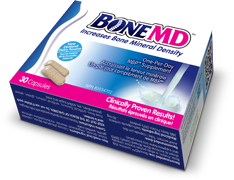Frequently Asked Questions
Click to proceed directly to these sections:
• BoneMD® FAQ
• General Bone Health FAQ
Frequently Asked Questions: BoneMD®
Q.Does BoneMD® contain calcium?
Can I take calcium with BoneMD®?
Should I continue to take calcium?
A.BoneMD® does NOT contain calcium. Yes, you CAN take calcium with BoneMD®. BoneMD® helps calcium adhere to the bones by increasing osteoblast formation. Generally, the calcium from your diet will be sufficient. All the studies done on MBP™, the raw material in BoneMD®, were done WITHOUT extra calcium supplementation. If you require extra calcium supplementation, BoneMD® will help to maximize the effectiveness of that supplementation.
Q.Should I take more than one BoneMD® capsule per day (40 mg)?
A.Increased amounts have not shown to increase bone mineral density to a greater degree. 40 mg is optimal.
Q.Why do the directions specify only a dosage for women? Can men take BoneMD®?
A.While women have a higher incidence of osteoporosis due to a smaller frame and menopausal issues, men also experience bone loss. Most of the studies done on MBP™, the material in BoneMD®, have been conducted on women and this is what the approved BoneMD® claim from Health Canada is based on. Men CAN take BoneMD® and there is a clinical study showing its effectiveness.
Q.For how long should one take BoneMD®?
A.Bone formation happens very slowly, so BoneMD® needs to be taken for a long period of time and ideally on a continual basis for those at risk. The clinical studies on MBP™, showing increased bone mineral density, were conducted over a six-month period. BoneMD® 90’s size is priced so that consumers can supplement affordably long-term.
Q.Is BoneMD® only for those who have osteoporosis?
A.No. MBP™ has been clinically proven to increase bone mineral density in both menopausal and PRE-menopausal women. It can be used for treatment AND prevention. The best way to avoid osteoporosis is to build up bone prior to menopause, the time of life most associated with bone loss.
Frequently Asked Questions: General Bone Health
Q.If I consume the right amount of calcium, will my bones automatically regenerate?
A.No matter how much calcium we ingest, our bones will not be able to utilize calcium effectively if the bones are unreceptive. If the calcium we consume is not incorporated into our bones, it flows out of the body as waste. Calcium is only one of the important building blocks in the formation of bones. Bone cells that do not function properly are unable to effectively utilize the available calcium. The cells that actually build the bone are called osteoblasts. The cells that dissolve old bones are called osteoclasts. The proper balance between osteoblasts and osteoclasts is essential for healthy bone formation.
It is interesting to note that despite the high consumption of calcium in North America, rates of osteoporosis are very high.
Q.What other nutritional substances, minerals, and vitamins help regenerate bones?
A.Other substances that facilitate bone regeneration include vitamin D, casein phosphopeptides (CPPs), magnesium, vitamin K, and isoflavones. Vitamin D and casein phosphopeptides (CPPs) enhance calcium absorption. In addition, various food substances play an important role in bone regeneration. Magnesium and vitamin K are important for their roles in stimulating bone formation, while isoflavones inhibit bone resorption. Key food substances involved in bone regeneration:
| Ingredient | Supplements calcium | Accelerates calcium absorption | Increases Osteoblast formation | Promotes collagen formation by osteoblasts | Promotes bone calcification | Reduces number of osteoclasts | Inhibits bone resorption by osteoclasts | Natural sources |
|---|---|---|---|---|---|---|---|---|
| Calcium | Milk, yogurt, cheese | |||||||
| Vitamin D | Sunlight, fish, mushrooms | |||||||
| Magnesium | Sesame seeds, buckwheat, bananas | |||||||
| Vitamin K | Natto beans, spinach, broccoli | |||||||
| Isoflavone | Soybean products | |||||||
| Milk, yogurt |
Q.How long does it take human bones to regenerate?
A.It takes approximately three years for human bones to completely regenerate.
Q.What is osteoporosis?
A.Osteoporosis means “porous bone” and is the most widespread bone disease affecting adults as they age. With osteoporosis, the bone becomes increasingly fragile. Consequently, bones affected by osteoporosis are at greater risk for breaks. It is known as a silent disease because it can go undetected for years until severe skeletal deterioration is noticeable or a bone is fractured.
Q.Who gets osteoporosis?
A.Osteoporosis typically affects women, starting at age 50, and men, starting at age 60. Women are 4 times as likely to develop osteoporosis as men. Women are more likely to develop osteoporosis, frequently due to hormonal changes that occur during menopause.
Q.What is osteopenia?
A.With osteopenia, bone mineral density (BMD) is below normal level, but not low enough to be diagnosed as osteoporosis. While there are no visible symptoms, osteopenia can be determined with a bone mineral density (BMD) test. Some people may naturally have lower bone density, making them more susceptible to osteoporosis. Women have a lower peak BMD than men and women are at greater risk for osteopenia due to menopause-related hormonal changes.
Q.Can exercise help my bone health?

A.Yes. Regular, weight-bearing exercise also helps bones stay strong and vital. Visit the Osteoporosis Canada website for more information: www.osteoporosis.ca for more information.
Various activities and sports can contribute to your bone fitness. These include football, basketball, baseball, jogging, dancing, jumping rope, inline skating, bicycling, dancing, hiking, skiing, swimming, rowing a canoe, bowling, and weight-training. Even everyday activities such as mowing the lawn, gardening, raking leaves, or washing and waxing the car, can be a plus for bone vitality.1
Source: 1. http://www.cfsan.fda.gov/~dms/fdbones.html accessed 7/11/06.
Clinically Proven Results!